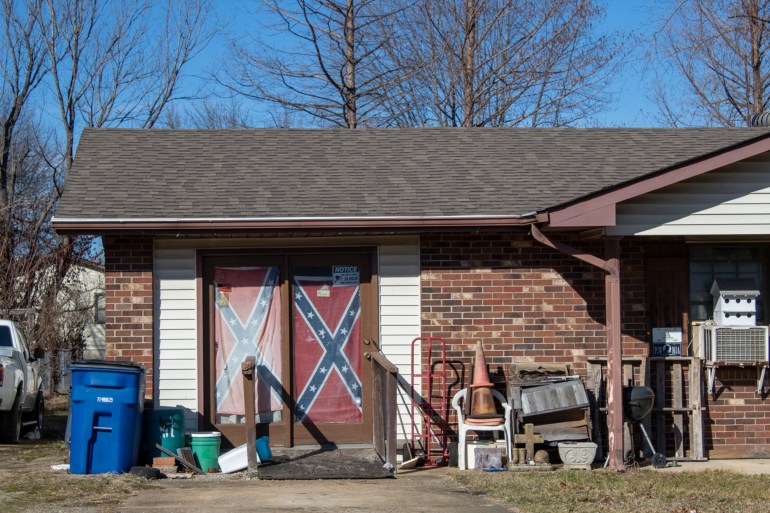On February 28, 2021, just after 9pm, nine Muslim men removed their shoes, lined up in single file, and knelt quietly for Isha, their faith’s mandatory night prayer, inside a Missouri state prison in the small city of Bonne Terre.
Their action was neither unusual nor provocative. The men had been praying together in the common space of their wing at Eastern Reception, Diagnostic and Correctional Center (ERDCC) for several months without incident, up to four times a day, after COVID restrictions put the prison’s chapel off-limits.
They lived in Housing Unit Four or 4-House’s B wing, which was known as the “honour dorm” and was reserved for prisoners with no recent infractions. In other wings of the men’s prison, prisoners were given limited time out of their cells. But in the honour dorm, the men could be out of their cells all day long in the wing’s ground floor common area, heating food that they had purchased at the commissary in the shared microwave, or gathering to talk or play cards or chess at tables bolted to the concrete floors.
The group of worshippers who gathered to pray at the back of the common area began with three prisoners and had grown to between nine and 14. Qadir (Reginald) Clemons, 52, who usually gave the call to prayer, says he had periodically checked in with the prison chaplain, and the “bubble officer” in the control room, which commanded a view of all four wings, to confirm that there would be no problem with the group praying. Christian prisoners also held communal prayer circles throughout ERDCC, including in the honour dorm.

On this night, however, the kneeling men would be charged at by prison guards. Five of them would be doused with pepper spray until they writhed in pain. Seven would be shackled and, most of them shoeless, marched about 50 metres through the winter mud of a recreation yard to another housing unit where they would be put into solitary confinement, also called administrative segregation, AdSeg, or simply – “the Hole”.
The group’s leader, Mustafa (Steven) Stafford, 58, a short, jovial man whom the others called “Sheikh” due to his commitment to Islam, would be assaulted en route to AdSeg and again once there. After their release from the Hole 10 days later, Stafford and others would face further retaliation.
None of the men – who dubbed themselves the “Bonne Terre Seven” after the incident – were accused of anything aside from disobeying a lieutenant’s orders to stop praying, which their faith dictates they cannot do, except in an emergency. According to the now-retired lieutenant, no prison official was disciplined over the incident.
This account of a peaceful prayer’s violent disruption and its aftermath is based on dozens of in-person and telephone interviews, including with six of the Bonne Terre Seven, eight other prisoners who witnessed the attack and several officers. It is bolstered by accounts from a lawsuit filed in 2022 by Clemons, now amended to include his eight fellow worshippers, who are petitioning the court to declare that the Missouri Department of Corrections (MODOC) cannot deny their religious rights and to award them damages for what they suffered. It also draws on interviews with human and prisoner rights advocates and the men’s lawyers from the Council on American-Islamic Relations (CAIR).
The picture that emerges is of a facility, and a larger prison system, that often treats Muslim prisoners, the majority of whom are Black, with suspicion, hostility and racism.
Even against this backdrop, the ERDCC attack stands out for its savagery. “I’ve never seen a case that involves this level of violence,” says Kimberly Noe-Lehenbauer, a CAIR lawyer representing the nine victims.
The prison
ERDCC is located on the outskirts of Bonne Terre in the low, rolling hills of the Ozark Plateau, 60 miles (96.6km) south of Missouri’s second-largest city, St Louis.
Bonne Terre is in St Francois County, which is nearly 93 percent white and squarely Republican; 73 percent of voters supported Donald Trump in the 2020 election. Trump signs still proliferate today, along with other markers of local beliefs; a “Jesus Loves You” billboard sits on the side of a state highway, followed soon after by a front door wrapped in the Confederate flag.

ERDCC opened in 2003, bringing a new main industry to the former mining town, whose centre sits atop a large mine that was shuttered in 1962. The city has a population of under 7,000, including the prisoners, which as of July 2020 numbered nearly 2,600 men.
ERDCC is a sprawling D-shaped mixed-security encampment. It has the state’s largest prison population and encompasses 11 housing units, 10 of those with four wings and a control unit or “bubble” in the centre.
The encampment also has a dining hall, a building housing educational programmes and a medical facility, three recreational yards, an intake area, and a small factory where some prisoners produce soap and other cleaning supplies. A visitation room lies in a building just past the prison entrance. That same building houses Missouri’s only execution chamber, though condemned prisoners are held in Potosi, 15 miles (24km) west, and brought to ERDCC shortly before their scheduled execution.







